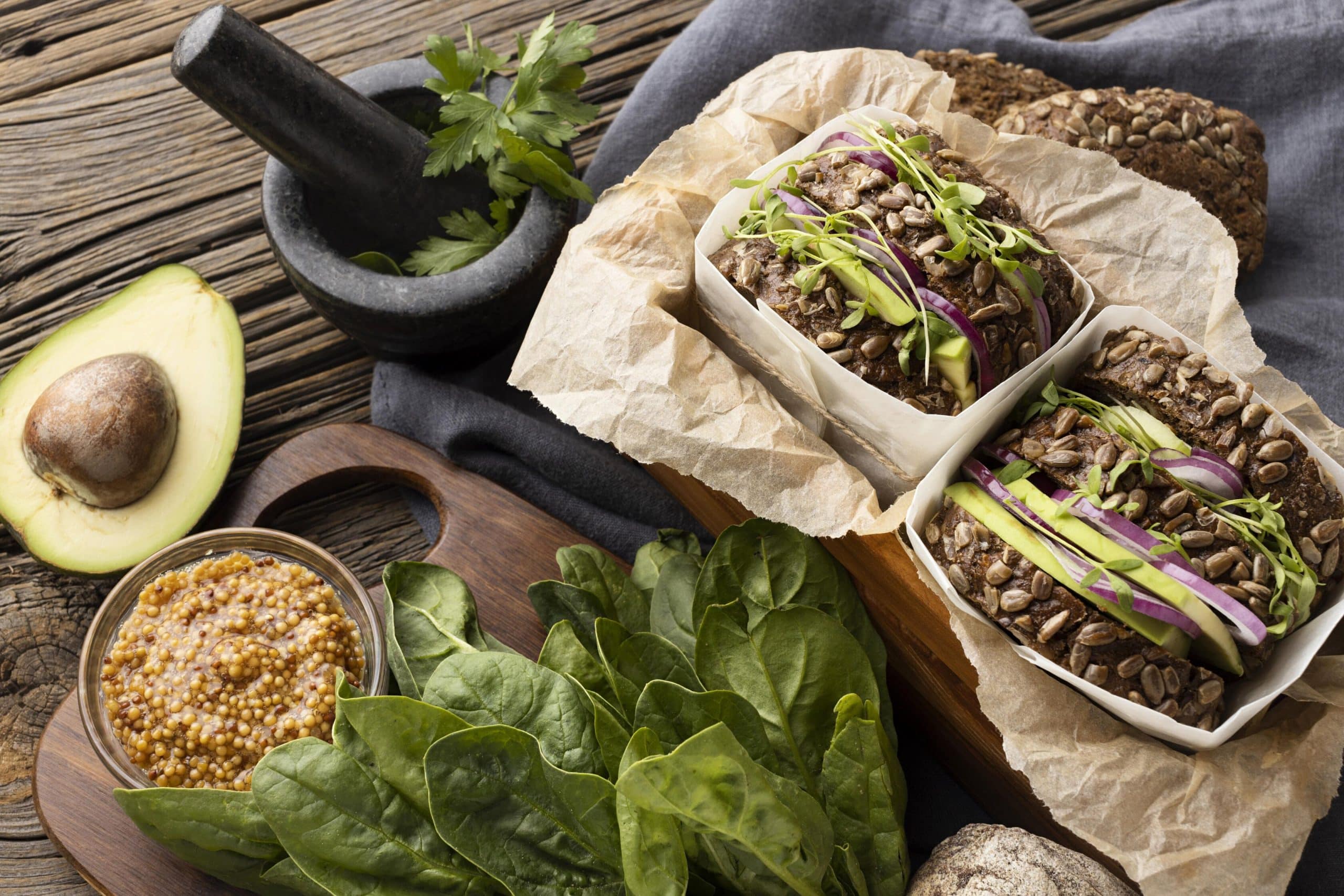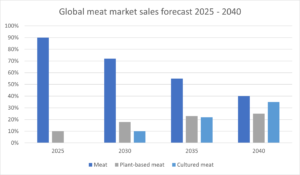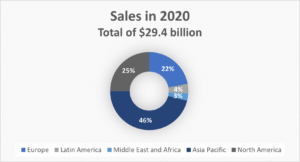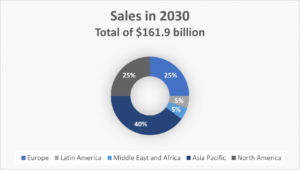Plant-Based Food Market: Growth and Future Outlook

Table of Contents
Food production, particularly meat production, is a major contributor to nearly 60% of the planet-heating gases emitted by humans. This article delves into the significant growth of the plant-based food market in recent years and its projected expansion over the next decade, highlighting the major consumer trends driving this growth.
How does meat consumption contribute to climate change?
Greenhouse gases, such as carbon dioxide and methane, significantly affect the earth’s temperature. The most known greenhouse gas is carbon dioxide (CO2). But there are other gases responsible for the greenhouse effect, such as methane, which is up to 34 times more damaging to the environment than CO2 if measured over 100 years; this ratio increases to 86 times more damaging if measured over 20 years.
Livestock produces significant amounts of methane as part of their normal digestive processes, and when there is an overconsumption of cattle, there is a strong increase in gas emissions. According to recent studies, by 2050, global meat consumption is projected to reach between 460 million and 570 million tons, which is twice as high as in 2008. And clearly, Processing and transporting this livestock further increases emissions.
Livestock emissions make up about 14.5 percent of the total global greenhouse gas emissions, and roughly 2/3 of those emissions come from cattle. Meat production is responsible for 57% of all food production emissions; 1 kilo of beef generates around 70 kg of greenhouse gas emissions. Meat production also contributes to the exhaustion of water resources. The UN states that producing one quarter-pound burger consumes around 1,500 liters of water.
In addition to the gas emissions, raising meat requires a large quantity of feed, and cattle ranching requires millions of acres of land and monoculture crop fields to feed this livestock. Cattle ranching drives deforestation 5 times more than any other sector and is responsible for a great majority of the Amazon forests; estimates show that about 70% of its deforested land is used for cattle. Converting natural habitats to agricultural fields releases greenhouse gases that contribute to climate change.
As a result of these facts, the plant-based movement has been growing as people understand the relationship between their food choices and the planet’s health. From the planet’s perspective, plant-based foods would require 37% less water, and their production would generate significantly lower gas emissions. This is where the race for market share begins.
Plant-based food: the future?
The plant-based food market globally is expected to reach $162 billion by 2030, up from $29.4 billion in 2020.
A report published by Bloomberg in 2021 stated that global retail sales of plant-based food alternatives (meaning food that consists of all minimally processed fruits, vegetables, whole grains, legumes, nuts and seeds, herbs, and spices and excludes all animal products) may reach $162 billion by 2030, which is an increase of more than $100 billion compared to 2022. The plant-based market is growing 5 times faster than the overall food industry. In the Middle East and Africa, the plant-based meat and dairy products market is projected to witness a CAGR of ~6% from 2022 to 2027.
As more people are moving toward a healthier and cleaner lifestyle, the term “flexitarian” (meaning a casual vegetarian) is growing fast. With 14% vegetarians and vegans worldwide and 15% flexitarians, this means that 29% of consumers globally are now embracing plant-based alternatives
The Asia-Pacific region has the largest share of the global plant-based market, and with a growth scenario of around $51 billion from 2020 to 2030, its market could reach $64.8 billion. This growth is driven by cultural and demographic factors, since the region’s population is expected to exceed 5 billion people by 2030, increasing the demand for plant-based alternatives.
-
Plant-based meat
In 2025, the global meat market share is expected to reach 90% of the global meat supply, and this ratio is expected to decrease by 50% in 2040. While meat alternatives are expected to increase by around 15%, reaching 25% of sales during the same period, cultured meat (genuine meat that is produced by cultivating animal cells directly) is expected to increase by 35%. These predictions demonstrate the market potential of plant-based alternatives, and that plant-based and cell-based meat will account for most of the meat sold by 2040 (with a combined share of 60%).

The Asia Pacific plant-based food market was valued at $17.1 billion in 2020 and is forecasted to grow at a CAGR of 15.9 percent between 2018 and 2026. With a market share of 37.9% in 2020, China dominates the Asian plant-based food market. On top of that, the Chinese government is planning to reduce meat consumption in the country by 50% by 2030. According to a study published in 2021 by DuPont Nutrition & Biosciences and IPSOS, demand for plant-based meat substitutes in China and Thailand is expected to increase by 200% by 2025.
In the US, the plant-based food market reached $7 billion in sales in 2020, compared to $4.8 billion in 2018, recording a growth of 43%. The growth of plant-based food sales has outpaced the growth of total food sales by 2.5 times during that same period
The table below illustrates the top 5 companies in meat alternatives by dollar share:

In the Middle East, meat alternatives are increasing, for instance, UAE-based Halal food brand Al Islami launched its first vegan burger in 2021.
In 2019, the global plant-based meat market reached $19 billion, with the Middle East accounting for $176.5 million, and was projected to grow by 4 to 5% annually until 2023.
-
Plant-based milk
The plant-based milk and derivatives market has already disrupted the dairy market and still has significant room for growth. Multiple factors are contributing to this growth potential, including lactose intolerance, and rising health concerns. According to the Food Intolerance Network, as much as 75% of the world’s population is lactose intolerant. Dairy products also contain high levels of saturated fats, which increases the risk of high cholesterol. As people are moving toward a healthier lifestyle, plant-based dairy alternatives have the potential to reach $68.8 billion by 2030, compared to their 2021 value of $25.2 billion, growing at a CAGR of 11.8% from 2022 to 2030
In the Asia-Pacific region, alternative dairy products are projected to make up 57% of the plant-based protein market by 2030
In the GCC region, 65% of consumers suffer from lactose intolerance, and 48% of consumers claim to prefer the taste of almond and oat milk to cow’s milk. Lulu hypermarket, a leading supermarket in the UAE, stated that the plant-based milk market has grown by 50% in 2020.
New market access
Millennials and Gen Z are more likely to become vegetarians and vegans, as they are more environmentally aware and have a strong sense of social responsibility. Regarding their consumption, 63% of Gen Zers consume a vegetarian or vegan meal at least once per month, and 44% do so once a week or more. According to a 2022 report, 79% of millennials and Gen Zers are already regularly eating plant-based.
In the United States, while only 2.5% of Americans over the age of 50 consider themselves vegetarians, 7.5% of Millennials and Gen Z have given up meat. Since future consumers are millennials and Gen Z, companies are focusing on offering products that appeal to them.”
The plant-based food industry is rapidly expanding and capturing a sizable market share; it also shows promising growth potential over the next 10 years. Therefore, now is the time for companies to innovate and develop plant-based alternatives. Interest in alternative proteins, for instance, is increasing globally, as plants have limited environmental impacts and are a healthy alternative filled with protein. Although alternative proteins accounted for only 2% of the world protein market in 2020, they are expected to reach 12% by 2035. Pea protein, for instance, grew at a 30% CAGR from 2004 to 2019.
Animal protein will stay prevalent in the market; this, however, does not eliminate the room for plant-based foods to grow and solidify their place in the market. According to a Bloomberg study, the plant-based food market is estimated to hit $162 billion in the next 10 years.
Sources:
https://www.theguardian.com/environment/2021/sep/13/meat-greenhouses-gases-food-production-study
https://www.myclimate.org/information/faq/faq-detail/what-are-greenhouse-gases/
https://unece.org/challenge
https://news.un.org/en/story/2018/11/1025271
https://www.cleanwateraction.org/features/meat-industry-%E2%80%93-environmental-issues-solutions
https://www.bbc.com/news/explainers-59232599
https://www.sustain.ucla.edu/food-systems/the-case-for-plant-based/#:~:text=Now%2C%20for%20those%20of%20you%20worried%20about%20protein%20content%3A&text=From%20a%20water%20perspective%2C%20using,to%20eat%20plant-based%20foods.
https://www.forbes.com/sites/christophermarquis/2021/03/02/plant-based-foods-are-our-future-and-entrepreneurs-are-helping-us-make-the-shift/?sh=7dbeae5351f5
https://insideclimatenews.org/news/21102019/climate-change-meat-beef-dairy-methane-emissions-california/#:~:text=Emissions%20from%20livestock%20account%20for,for%20grazing%20and%20feed%20crops.
https://www.theworldcounts.com/challenges/consumption/foods-and-beverages/world-consumption-of-meat/story
https://www.washingtonpost.com/world/interactive/2022/amazon-beef-deforestation-brazil/
https://www.livekindly.co/middle-easts-vegan-food-market-growing-fast/
https://assets.bbhub.io/professional/sites/10/1102795_PlantBasedFoods.pdf
https://foodspecialities.com/industry-news/dairy-ingredients-industry-news/high-margin-growth-opportunities-with-plant-based-milks/
https://cultivateinsights.com/2019/07/22/alternative-meats-could-be-60-of-the-market-by-2040/
https://gfi.org/marketresearch/
https://thevou.com/lifestyle/2019-the-world-of-vegan-but-how-many-vegans-are-in-the-world/#:~:text=Right%20now%2C%20the%20total%20number,percent%20of%20the%20world%20population.
https://foodinstitute.com/focus/veganuary-2022-coincides-with-growing-flexitarian-trend/#:~:text=Flexitarians%20are%20more%20flexible.&text=It’s%20estimated%2015%25%20of%20the%20population%20already%20is%20flexitarian.
https://tradeinsights.amys.com/millennial-gen-z-buying-habits-spell-growing-opportunity-for-plant-based/
https://www.visualcapitalist.com/sp/how-does-animal-meat-compare-to-plant-based-meat/
https://www.bloomberg.com/company/press/plant-based-foods-market-to-hit-162-billion-in-next-decade-projects-bloomberg-intelligence/
https://www.mordorintelligence.com/industry-reports/middle-east-and-africa-plant-based-meat-and-dairy-products-industry
https://web-assets.bcg.com/a0/28/4295860343c6a2a5b9f4e3436114/bcg-food-for-thought-the-protein-transformation-mar-2021.pdf
https://www.plantbasedfoods.org/marketplace/retail-sales-data-2020/
https://www.globenewswire.com/news-release/2022/05/18/2446161/0/en/Plant-Based-Meat-Products-Market-Size-Worth-US-14-527-55Mn-Globally-by-2028-at-15-3-CAGR-Exclusive-Report-by-The-Insight-Partners.html
https://www.globenewswire.com/news-release/2019/10/14/1929284/0/en/Plant-based-Meat-Market-To-Reach-USD-30-92-Billion-By-2026-Reports-And-Data.html
https://www.globenewswire.com/en/news-release/2022/08/16/2499600/0/en/Dairy-Alternative-Market-Size-to-Hit-USD-68-79-Billion-by-2030.html#:~:text=The%20global%20dairy%20alternatives%20market,11.8%25%20from%202022%20to%202030.

